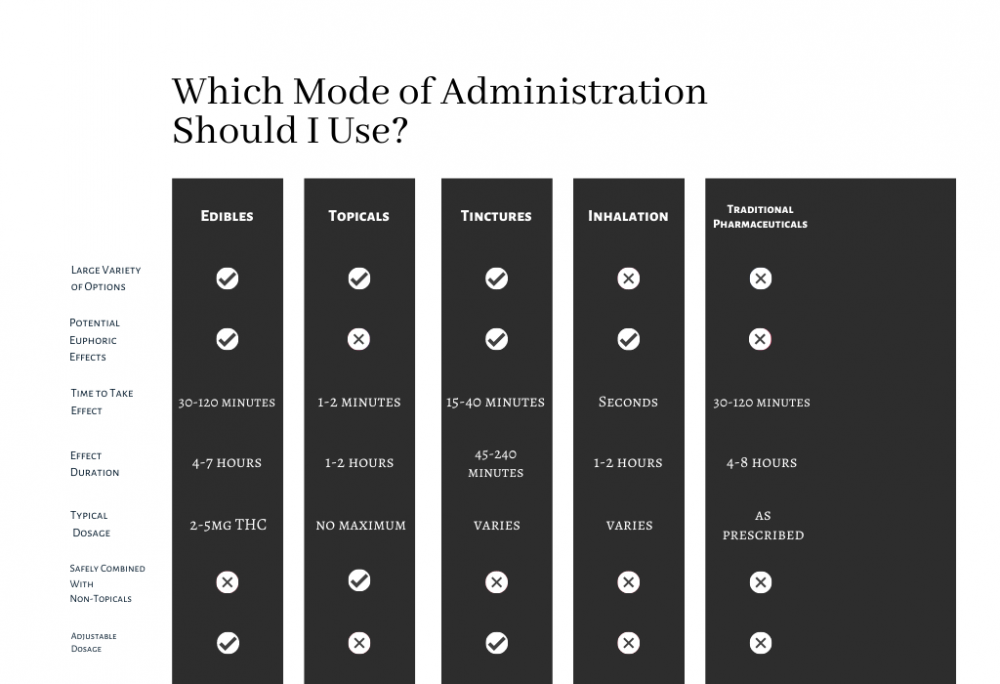
A Guide to THC Administration: What You Need to Know About Methods, Dosages, and Effects
When considering medical cannabis, the mode of administration is a crucial factor to consider. Each method—be it edibles, topicals, tinctures, or inhalation—has unique pharmacokinetics, including absorption rates and durations of effects. Factors such as time to onset, effect duration, and typical dosages also vary. We’ll delve into the specifics of each mode to better inform your choices.
Comparison Table
| Mode of Administration | Time to Effects | Effect Duration | Typical Dosage | Euphoric Consequences |
|---|---|---|---|---|
| Edibles | 30 min – 2 hrs | 4 – 12 hrs | 5 – 15 mg | Moderate to Strong |
| Topicals | 20 – 40 min | 2 – 5 hrs | Varies | Minimal |
| Tinctures | 15 – 45 min | 4 – 8 hrs | 5 – 15 mg | Moderate |
| Inhalation | Seconds | 1 – 3 hrs | 1 – 3 puffs | Strong |
Edibles
- Time to Effects: 30 minutes to 2 hours
- Effect Duration: 4 to 12 hours
- Typical Dosage: 5 – 15 mg of THC
- Euphoric Consequences: Moderate to strong
- Edibles are processed through the liver, leading to a delayed but often more potent effect. The psychoactive metabolite 11-hydroxy-THC is produced during first-pass metabolism in the liver, which is generally more potent than THC (Vandrey et al., 2019).
Topicals
- Time to Effects: 20 to 40 minutes
- Effect Duration: 2 to 5 hours
- Typical Dosage: Varies
- Euphoric Consequences: Minimal
- Topicals are generally used for localized relief and are less likely to produce euphoric effects as they don’t typically enter the systemic circulation (Pertwee, 2015).
Tinctures
- Time to Effects: 15 to 45 minutes
- Effect Duration: 4 to 8 hours
- Typical Dosage: 5 – 15 mg of THC
- Euphoric Consequences: Moderate
- Tinctures offer more controlled dosing compared to edibles and are absorbed more quickly.
Inhalation
- Time to Effects: Within seconds
- Effect Duration: 1 to 3 hours
- Typical Dosage: 1 – 3 puffs
- Euphoric Consequences: Strong
- The effects are immediate but may lead to quicker dissipation of effects. However, the rapid onset makes it easier to titrate the dose (Loflin et al., 2017).
References
- Vandrey, R., Raber, J. C., Raber, M. E., Douglass, B., Miller, C., & Bonn-Miller, M. O. (2019). Cannabinoid Dose and Label Accuracy in Edible Medical Cannabis Products. JAMA, 313(24), 2491–2493.
- Pertwee, R. G. (2015). Endocannabinoids and Their Pharmacological Actions. Handb Exp Pharmacol, 231, 1–37.
- Loflin, M., & Earleywine, M. (2017). A new method of cannabis ingestion: The dangers of dabs? Addictive behaviors, 71, 1-7.
Cautionary Note
For individuals with certain medical conditions such as liver disease, respiratory issues, or those taking medications that interact with cannabinoids, it is crucial to consult a specialized medical professional for personalized guidance. Contact Dr. Caplan at CED Clinic for tailored, thoughtful care in such scenarios.
📗 Note: Diagrams are like tweets; concise and to the point. Ready for the full article? Click to get “The Doctor-Approved Cannabis Handbook” 📗

Summary Notes
A Guide to THC Administration: Navigating Methods, Dosages, and Effects
Navigating the world of THC administration requires a comprehensive understanding of the various methods available, how dosages are calculated, and the effects THC can have on the body. Whether for medicinal or recreational purposes, the way THC is administered can significantly impact its efficacy and the user’s experience.
When considering the best methods for THC administration, individuals are faced with options ranging from inhalation and edibles to tinctures and topicals. Each method comes with its own set of benefits and considerations, including differences in onset time, duration of effects, and ease of dosage control. For instance, THC oil and edibles offer longer-lasting effects but have a delayed onset compared to inhalation methods like smoking or vaping.
Understanding THC dosage is crucial, especially for beginners. Dosage can vary widely based on factors such as the individual’s tolerance, the method of administration, and the desired effects. Calculating the right THC dosage involves starting with low amounts and gradually increasing as needed, always mindful of the potential for overconsumption and adverse effects.
The impact of THC on cognitive functions and overall safety considerations cannot be overstressed. While many users enjoy the relaxation and euphoria THC can provide, it’s important to be aware of potential side effects, including impaired memory, coordination, and judgment in the short term, and possible long-term effects with chronic use.
Legal aspects also play a critical role in THC use and administration. With laws varying significantly by location, staying informed about local regulations is essential for lawful and responsible use.
Optimizing the effects of THC involves not only choosing the right administration method but also understanding the differences in absorption rates and potential interactions with other medications. Personalized THC treatment plans, particularly in medical contexts, can help achieve the desired therapeutic outcomes while minimizing risks.
Navigating THC side effects, tolerance management, and specific medical applications requires ongoing education and consultation with healthcare professionals. As research into THC continues to evolve, future directions promise to further our understanding of its potential benefits and limitations.
This guide aims to equip readers with the foundational knowledge needed to make informed decisions about THC administration, emphasizing the importance of responsible use, personalized approaches, and adherence to legal guidelines. As the landscape of cannabis use continues to change, staying informed and cautious will ensure the best possible outcomes for THC users.

